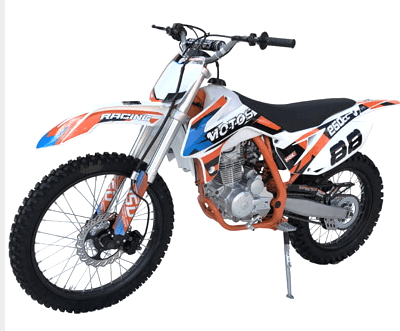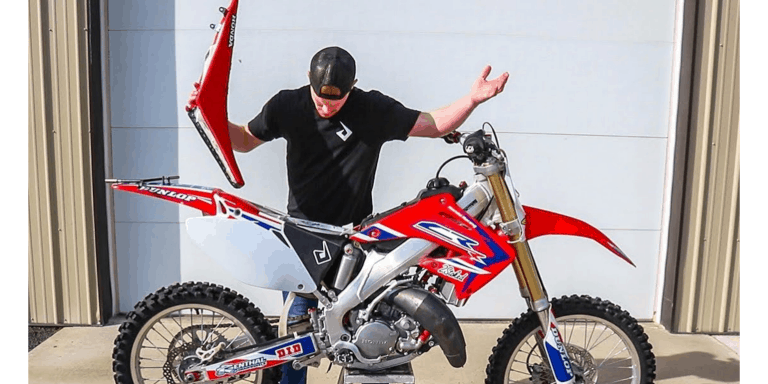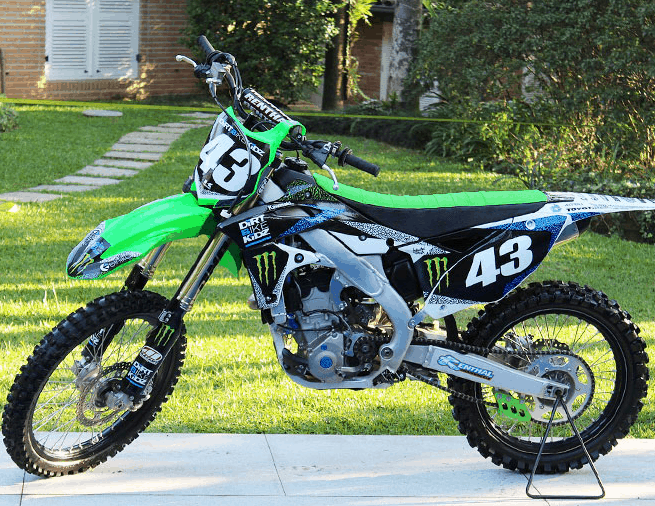2 Stroke Vs 4 Stroke Dirt Bike Trail Riding
Table of Contents
The piston moves up and down in the cylinders during the combustion cycle of an engine. The piston positions in the cylinders are referred to by the words “Top Dead Centre” (TDC) and “Bottom Dead Centre” (BDC). TDC is its closest view to the valves and BDC is its most faraway position.
The piston steps between TDC and BDC or vice-versa is a stroke. The whole process of gas and air being sucked into the piston ignited and expelled from the exhaust is a combustion revolution or combustion phase.
A stroke is a piston momentum which means that a two-stroke dirt bike has two separate piston movements, whereas a 4-stroke movement has 4. 2 Strokes are usually more unsteady and faster, while a 4-stroke is compatible and speed is significantly greater.
In short, a stroke is a step towards making the dirt motorcycle engine work. After all, two-stroke engines use two ‘movements’ or strokes to finish the whole ‘engine cycle,’ whereas four-stroke drives use four-piston strokes to do the same.
Here are the differences between Trials bike 2 stroke vs. 4 stroke as related to weight, maintenance, etc.
2 stroke vs 4 stroke dirt bike trail riding
Two Stroke Dirt Bike
The far less complex method from the two engines is two-stroke engines. They are engineered to execute their engine cycle, in two piston mobility.
A potent stroke starts the two-stroke motorcycle. The inflamed air, fuel, and oil blend force the piston down to an entrance on the side of the cylinder until the blend approaches the exhaust nozzle.
The piston drops down and pushes the air, fuel, and oil compound, previously drawn into an attachment on the side known as the crankcase, due to pressure. Through the most recently concluded compression stroke, the combination was dragged into the crankcase, the one before the current power stroke.
The next air and fuel solution in the cylinder can be pushed by an exposure absorption transmission port, as the crankshaft starts its next rotation. The activity inhibits the exhaust and intake ports to allow the fuel and air solution to be compressed by the piston.
The upward activity of the piston draws from the carburetors into the nearest fuel and air mix and maintains them under the piston. A spark plug ignites the currently compacted air and fuel charge above the piston and repeats itself over and over again.
This procedure yields less waste than the equivalent or comparable power output four-stroke engine. They can be installed and maintained using 30 or 50% less movable parts than a four-stroke. They are a more reliable framework. The most convenient to clean among the two types of engines are the two strokes. Their consumption is high, however, and based on the way the engine’s stroke operates with chamber openings, it generates more emissions.
Also, with entrance and drainage ports opening at the very same moment, a component of the air and fuel mixture misses from the exhaust port at each piston oscillation without using the engine. In other words, the exclusions to these regulations are direct injections and catalyst converters, reducing the number of exhaust gas in your emissions.
They involve the integration of fuel and oil because of the manner in which they are manufactured. Two-stroke engines usually need more servicing, although the components are less expensive. Two-stroke bikes are typically lighter and faster, with more of a first “go and up” kick.
Although they need a half-stroke to fulfill the very same objective as a four-stroke engine, they make twice the noise. Two-stroke engines are starting to gain a higher RPM torque.
Two-stroke dirt bike’s engines are usually lighter, make a higher loud sound, and are affordable than 4-stroke dirt bikes. For newcomers 250 2 stroke for beginner is the best option for trail riding.
Pros of Two Stroke Dirt Bike
- Lightweight
Since two-stroke dirt motors are easier and condensing, four steps are smaller and lighter than four-stroke engines. For several reasons, having a lightweight dirt motorcycle can be decent.
- Affordable Price
Newly designed 2-stroke dirt motorcycles are affordable on the front than four-stroke due to the engine capacity and fewer components.
Cons of Two Stroke Dirt Bike
- More shifting
Since the two-stroke dirt cycling engine works on just a two-stroke cycle, it produces more energy per stroke. While that makes things such as faster initial acceleration possible.
- More maintenance
Although having a simpler engine is a fantasy when doing your own maintenance, the two-stroke engine has some specific disadvantages.
- Not Environment friendly
Due to the two-stroke engine work double the speed of a four-stroke engine, fuel consumption is higher. During start-up, two-stroke dirt cycles tend to “smoke.” Both the exhaust and burnt oil is released into the atmosphere. These are emissions that are polluting the environment in the atmosphere.

Four Stroke Dirt Bike
Four-stroke dirt bike engines are significantly more complex than the two-stroke engines. The title suggests that a four-stroke engine takes four repeated strokes, or movements, to finish an engine momentum. This involves more components, and a heavier engine is produced.
There are four components in four-stroke dirt bike engines: intake, contraction, combustion, and emissions. The four-stroke engines fire every two oscillations on the shaft instead of firing each revolution, as does the two-stroke engine.
To obtain this unique engine cycle, a four-stroke engine takes four-piston motion. The piston lowers on the first, or “intake,” stroke, pulling in air and fuel blend. Next, the air and fuel blend will be raised for a “compression” stroke.
This ignition forces the piston down for the “power” stroke, swiftly followed by the “exhaust “stroke, pressing the exhaust out of the engine. These patterns rephrase over and over again, the entire running time of the bike.
Each of the two-revolution crankshaft four-stroke engines “fire,” providing a smoother, more easily influenced outcome. A four-stroke engine is usually much better for beginners as well as for trail riders. On a four-stroke trail, you hardly ever ride just above second gear, as it can be significantly greater than the two-stroke trail.
A four-stroke engine seems to have more components, allowing you to brake and shifting your bike less time if you have to relatively slow. Restoration is much less necessary since the work the engine does has spread over more components.
Regrettably, this also implies that it is usually more expensive when maintenance is required because more parts must be processed and substituted. These extra parts are also heavier than their two-stroke counterparts for four-stroke engines.
From an exhaust emissions perspective, 4 stroke engines are a very clean burning engine. This is because the fuel consumption is higher than that of the two-stroke engine and you must not mix oil with your fuel in order to operate your engine.
Four-stroke engines are heavier, leading to a heavier bike when similar cubic cm is involved, weighing almost always 50 percent higher than comparable two-stroke engines. Due to the increased number of components, they are often much tougher than cleaning. You will receive the most torque at a lower RPM from four-stroke engines.
Four-stroke engines are very useful but aren’t as effective as a two-stroke motor. Four-stroke dirt bikes are heavier than two-stroke drive dirt bikes, they are indeed a deeper noise, and when it relates to fuel consumption, they are more clean combustion.
Pros of Four Stroke Dirt Bike
- Less Shifting
Based on the way a four-stroke engine is constructed, a dirt engine with a four-stroke engine is termed as a broader powerband. The powerband is the most cost-effective range of speeds an engine can operate. As there are a wider range of speeds available for a four-stroke engine to run effectively, brake, shift, and clutching.
- Easy to handle
Dirt motorcycles with two-stroke engines are more “jumpy,” and although that gives them vaunted fastness, it makes them somewhat harder to manage, especially if you’re smaller, less experienced, or feel like you’re riding the old lawnmower.
Whereas, four-stroke engines have low gear shifting and have the power to get the full acceleration.
- Reliable Output
As a two-stroke drive gives you twice as often firing strokes that a four-stroke engine, a four-stroke bike gives you a firmer and more efficient power output, making your bike “read” easier while driving and always gives you a smoother sensation.
Cons of Four Stroke Dirt Bike
- Heavy to handle
The four-stroke engine has a larger number of components than the two-stroke engine, making the engine heavier and much more complex. This should be remembered because weight is very essential when riding dirt.
You may not have to think too much about extra weight if you normally consider yourself “just” a trail rider or your dirt bike to be enjoyable, or the impact of a few added ounces or pound at the peak speed might just have.
- Expensive Maintenance
Repairs of a four-stroke dirt bike seem to be something you certainly need to remember before you buy one. Four-stroke engines are heavier and it has more sections, often 50% heavier than that of the two-stroke engines.
More elements imply more parts to repair, and more opportunities are for something to break down just because there are more things to remove.
Similarities of 2-Stroke and 4-Stroke Dirt Bikes
After knowing all the 2 strokes vs. 4 stroke enduro or differences, let’s also know that there are few similarities among them both as well; such as:
- There are also a few resemblances in defining the variations that can be seen:
- Two-stroke engine and four-stroke engine both have pistons that keep them running.
- Both engines are comprehensive in basic stages: intake, compaction, combustion, and exhaust.
- Their procedures are designed for the dirt motorcycles to run and move easily.
Conclusion
Depending upon the generations these bikes are used by the riders full of confidence and satisfaction. It is hard to verify whether two-stroke is better or four-stroke is better. Once upon a time, two-stroke was the only option to ride and enjoy but now the latest technologies are launched with extra protection and ultimate power of four-stroke engines.
There are certain 2 strokes or 4 stroke dirt bikes for beginner which are manufactured for the newcomers in the trail riding. Heavy engines or fast bikes are not safe for beginners.
Whereas the environment issues are related then it is strictly advised to ride four-stroke dirt bikes which are of pollution-free and do not create any harm to the society. While riding bikes it is advised to ride safe and ride with proper gears for your protection and safety.
- Top 7 Best Dirt Bike Handlebars [Updated] - February 13, 2022
- How Fast Does A 150cc Dirt Bike Go - August 14, 2021
- How Fast Does A 200cc Dirt Bike Go - August 14, 2021







